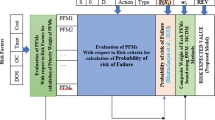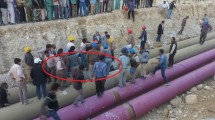Abstract
Determining the share of project cost progress is among the essential issues in the planning phases of financial management and earned value management (EVM). The performance baseline is set up in the planning phase to measure cost deviations during project execution. Then, an estimate at completion (EAC) is forecasted based on the current cost progress. Traditionally, EVM only focuses on the cost performance index (CPI) and does not address other important aspects, such as complexity and risk, which are critical for all organizational stakeholders. In most cases, the cost factor is used to determine the percentage of the project’s financial progress. Despite its superior formulation, EVM forecasts are still influenced by project risks and uncertainties. These factors lead to inconsistency between EAC results obtained through standard formulae. In this study, a framework was developed in which a relatively complete set of criteria has been evaluated and ranked to improve cost progress estimation. Such criteria can be used in the proposed multi-criteria decision-making technique for activities related to peroxide project operations. Expert opinions in several groups have been collected using the group decision-making method. The risk of activities was identified using the Failure Modes and Effects Analysis (FMEA) method. In addition, the rank of activities was determined by the Multi-Objective Optimization based on Ratio Analysis based on G-number theory (G-MOORA) method with an uncertainty approach. Linguistic indicators of importance and necessity in the decision matrix G were fuzzified through triangular numbers. In the next step, these values were normalized to definite numbers, and the cost progress of the project was calculated. The output is a table proposing fixed weights, indicating that adding weighting dimensions changes the calculation of the project cost percentage of progress for well-known activities that can be widely used in construction and installation projects.







Similar content being viewed by others
References
Akbari, R., Dabbagh, R., & Ghoushchi, S. (2020). HSE risk prioritization of molybdenum operation process using extended FMEA approach based on Fuzzy BWM and Z-WASPAS. Journal of Intelligent and Fuzzy Systems, 38(4), 5157–5173. https://doi.org/10.3233/JIFS-191749
Aliverdi, R., Naeni, L., & Salehipour, A. (2013). Monitoring project duration and cost in a construction project by applying statistical quality control charts. International Journal of Project Management, 31(3), 411–423. https://doi.org/10.1016/j.ijproman.2012.08.005
Anand, A., Castello, A., & Lecoeuvre, L. (2021). A review and classification of the uncertainties in projects: The way forward. Revue Française De Gestion Industrielle, 35(1), 57–79. https://doi.org/10.53102/2021.35.01.916
Babar, S., Thaheem, M., & Ayub, B. (2017). Estimated cost at completion: Integrating risk into earned value management. Journal of Construction Engineering and Management, 143(3), 04016104. https://doi.org/10.1061/(ASCE)CO.1943-7862.0001245
Beigi, H., Mahpour, A., & Mortaheb, M. (2020). Success breakdown structure: Application to petrochemical projects success assessment. AUT Journal of Civil Engineering, 4(3), 333–348. https://doi.org/10.22060/ajce.2019.16406.5585
Beladi, H., Marjit, S., & Oladi, R. (2019). Inflating profits and industry competitiveness. International Journal of Economic Theory, 15(3), 281–287. https://doi.org/10.1111/ijet.12185
Brauers, W., & Zavadskas, E. (2006). The MOORA method and its application to privatization in a transition economy. Control and Cybernetics, 35, 445–469.
Dorosti, S., Fathi, M., Ghoushchi, S. J., Khakifirooz, M., & Khazaeili, M. (2020). Patient waiting time management through fuzzy based failure mode and effect analysis. Journal of Intelligent & Fuzzy Systems, 38(2), 2069–2208. https://doi.org/10.3233/JIFS-190777
Egwim, C. N., Alaka, H., Toriola-Coker, L. O., Balogun, H., Ajayi, S., & Oseghale, R. (2021). Extraction of underlying factors causing construction projects delay in Nigeria. Journal of Engineering, Design and Technology. https://doi.org/10.1108/JEDT-04-2021-0211
Eroğlu, H. (2021). Multi-criteria decision analysis for wind power plant location selection based on fuzzy AHP and geographic information systems. Environment, Development and Sustainability, 23(12), 18278–18310. https://doi.org/10.1007/s10668-021-01438-5
Ershadi, M., Jefferies, M., Davis, P., & Mojtahedi, M. (2021). Achieving sustainable procurement in construction projects: The pivotal role of a project management office. Construction Economics and Building, 21(1), 45–64. https://doi.org/10.5130/AJCEB.v21i1.7170
Fardi, K., Jafarzadeh-Ghoushchi, S., & Hafezalkotob, A. (2019). An extended robust approach for a cooperative inventory routing problem. Expert Systems with Applications, 116, 310–327. https://doi.org/10.1016/j.eswa.2018.09.002
Filippetto, A., Lima, R., & Barbosa, J. (2021). A risk prediction model for software project management based on similarity analysis of context histories. Information and Software Technology, 131, 106497. https://doi.org/10.1016/j.infsof.2020.106497
Ghoushchi, S. J., Bonab, S. R., Ghiaci, A. M., Haseli, G., Tomaskova, H., & Hajiaghaei-Keshteli, M. (2021a). Landfill site selection for medical waste using an integrated SWARA-WASPAS framework based on spherical fuzzy set. Sustainability, 13(24), 13950. https://doi.org/10.3390/su132413950
Ghoushchi, S. J., Dorosti, S., Khazaeili, M., & Mardani, A. (2021b). Extended approach by using best–worst method on the basis of importance, necessity concept and its application. Applied Intelligence, 4, 1–15. https://doi.org/10.1007/s10489-021-02316-3
Ghoushchi, S. J., Gharibi, K., Osgooei, E., Ab Rahman, M. N., & Khazaeili, M. (2021c). Risk prioritization in failure mode and effects analysis with extended SWARA and MOORA methods based on Z-numbers theory. Informatica, 32(1), 41–67. https://doi.org/10.15388/20-INFOR439
Ghoushchi, S., & Khazaeili, M. (2019). G-Numbers: importance-necessity concept in uncertain environment. International Journal of Management and Fuzzy Systems, 5(1), 27–32. https://doi.org/10.11648/j.ijmfs.20190501.15
Hassanpour, J., Firouzei, Y., & Hajipour, G. (2021). Actual performance analysis of a double shield TBM through sedimentary and low to medium grade metamorphic rocks of Ghomrood water conveyance tunnel project (lots 3 and 4). Bulletin of Engineering Geology and the Environment, 80(2), 1419–1432. https://doi.org/10.1007/s10064-020-01947-z
Hematinia, S., Rezaeyan, S., & Jozi, S. (2020). Environmental risk assessment of urban development projects Tehran 19th District using spatial EFMEA (Case study: The operation of provincial parks). Ustainability, Development & Environment, 1(2), 69–86.
Jafarzadeh-Ghoushchi, S., Dorosti, S., & Asgari-Tehrani, S. (2017). Characteristics of the research on value engineering (2000–2015) world review of science. Technology and Sustainable Development, 13(2), 101–116. https://doi.org/10.1504/WRSTSD.2017.084171
Khazaeili, S., Jafarzadeh, S., & Ghoushchi, M. (2019). G-numbers: Importance-necessity concept in uncertain environment. The International Journal of Fuzzy Systems. https://doi.org/10.11648/j.ijmfs.20190501.15
Koke, B., & Moehler, R. (2019). Earned green value management for project management: A systematic review. Journal of Cleaner Production, 230, 180–197. https://doi.org/10.1016/j.jclepro.2019.05.079
Lalmi, A., Fernandes, G., & Souad, S. (2021). A conceptual hybrid project management model for construction projects. Procedia Computer Science, 181, 921–930. https://doi.org/10.1016/j.procs.2021.01.248
Lin, Z., Ayed, H., Bouallegue, B., Tomaskova, H., Jafarzadeh Ghoushchi, S., & Haseli, G. (2021). An integrated mathematical attitude utilizing fully fuzzy bwm and fuzzy waspas for risk evaluation in a SOFC. Mathematics, 9(18), 2328. https://doi.org/10.3390/math9182328
Lipke, W. (2006). Earned schedule leads to improved forecasting (3 ed.). In International conference on project management (ProMAC 2006).
Liu, H. C., You, J. X., Ding, X. F., & Su, Q. (2015). Improving risk evaluation in FMEA with a hybrid multiple criteria decision making method. International Journal of Quality & Reliability Management. https://doi.org/10.1108/IJQRM-10-2013-0169
Oliveira, R. (2019). Monitoring and control of schedule and cost performance in facade conservation. Procedia Structural Integrity, 22, 151–159.
Pamucar, D., Deveci, M., Gokasar, I., & Popovic, M. (2021). Fuzzy Hamacher WASPAS decision-making model for advantage prioritization of sustainable supply chain of electric ferry implementation in public transportation. Environment, Development and Sustainability. https://doi.org/10.1007/s10668-021-01742-0
Rahmati, S., Mahdavi, M. H., Ghoushchi, S. J., Tomaskova, H., & Haseli, G. (2022). Assessment and prioritize risk factors of financial measurement of management control system for production companies using a hybrid Z-SWARA and Z-WASPAS with FMEA method: a meta-analysis. Mathematics, 10(2), 253. https://doi.org/10.3390/math10020253
Samee, K., & Pongpeng, J. (2016). Structural equation model for construction equipment management affecting project and corporate performance. KSCE Journal of Civil Engineering, 20(5), 1642–1656. https://doi.org/10.1007/s12205-015-0717-1
Terbrack, H., Claus, T., & Herrmann, F. (2021). Energy-oriented production planning in industry: A systematic literature review and classification scheme. Sustainability, 13(23), 13317. https://doi.org/10.3390/su132313317
Urgiles, P., Sebastian, M., & Claver, J. (2020). Proposal and application of a methodology to improve the control and monitoring of complex hydroelectric power station construction projects. Applied Sciences, 10(21), 7913. https://doi.org/10.3390/app10217913
Wang, J.-W., Cheng, C.-H., & Huang, K.-C. (2009). Fuzzy hierarchical TOPSIS for supplier selection. Applied Soft Computing, 9(1), 377–386. https://doi.org/10.1016/j.asoc.2008.04.014
Wi, H., & Jung, M. (2010). Modeling and analysis of project performance factors in an extended project-oriented virtual organization (EProVO). Expert Systems with Applications, 37(2), 1143–1151. https://doi.org/10.1016/j.eswa.2009.06.051
Wu, C., Wu, P., Wang, J., Jiang, R., Chen, M., & Wang, X. (2021). Ontological knowledge base for concrete bridge rehabilitation project management. Automation in Construction, 121, 103428. https://doi.org/10.1016/j.autcon.2020.103428
Zavadskas, E. K., Vilutienė, T., Turskis, Z., & Šaparauskas, J. (2014). Multi-criteria analysis of Projects’ performance in construction. Archives of Civil and Mechanical Engineering, 14(1), 114–121. https://doi.org/10.1016/j.acme.2013.07.006
Zayed, T., Amer, M., & Pan, J. (2008). Assessing risk and uncertainty inherent in Chinese highway projects using AHP. International Journal of Project Management, 4, 408–419. https://doi.org/10.1016/j.ijproman.2007.05.012
Zhang, X., Bakis, N., Lukins, T. C., Ibrahim, Y. M., Wu, S., Kagioglou, M., Aouad, G., Kaka, A. P., & Trucco, E. (2009). Automating progress measurement of construction projects. Automation in Construction, 18(3), 294–301. https://doi.org/10.1016/j.autcon.2008.09.004
Author information
Authors and Affiliations
Corresponding author
Additional information
Publisher's Note
Springer Nature remains neutral with regard to jurisdictional claims in published maps and institutional affiliations.
Rights and permissions
Springer Nature or its licensor holds exclusive rights to this article under a publishing agreement with the author(s) or other rightsholder(s); author self-archiving of the accepted manuscript version of this article is solely governed by the terms of such publishing agreement and applicable law.
About this article
Cite this article
Enayati Fatollah, S., Dabbagh, R. & Shahsavar Jalavat, A. An extended approach using failure modes and effects analysis (FMEA) and weighting method for assessment of risk factors in the petrochemical industry. Environ Dev Sustain (2022). https://doi.org/10.1007/s10668-022-02609-8
Received:
Accepted:
Published:
DOI: https://doi.org/10.1007/s10668-022-02609-8




